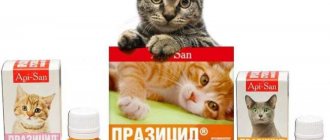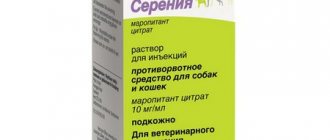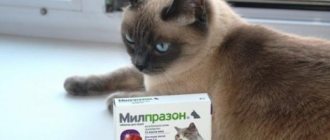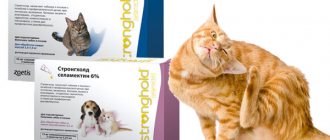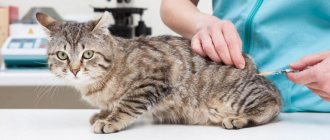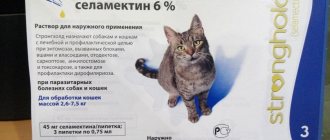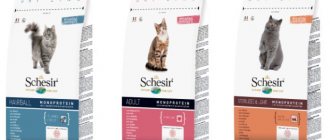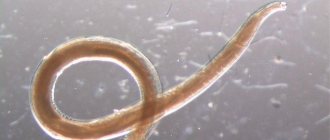| Article verified by a practicing veterinarian |
Preventive treatment of pets against helminths is mandatory item when keeping them.
Even if a pet does not go outside, it can become infected with helminths through the owner’s shoes, objects brought from the street, grass collected from the street, soil for indoor plants, etc. Some types of worms can be transmitted from pets to humans. The topic of deworming is especially relevant if there are children in the house.
In the fight against parasites, veterinary pharmacology offers a wide range of means. Let's look at the drug Prazicide for cats: how to give it, dosage, possible side effects and contraindications.
Composition and action
Prazicide contains two active components:
- pyrantel pamoate;
- Praziquantel
Thanks to a well-developed formula, the drug does not have a negative effect on the most important organs and systems of the pet, while it has a detrimental effect on intestinal parasites. Pyrantel pamoate is a synthetic broad-spectrum anthelmintic substance. Getting through the stomach into the intestines, pyrantel blocks the neuromuscular system of the parasite, causing its further death.
Pyrantel pamoate is active against nematodes - roundworms that parasitize the intestines of cats. The substance acts on mature and immature helminths, but is ineffective against migrating larvae.
Pyrantel has a targeted effect on the following types of roundworms:
- roundworms;
- pinworms;
- hookworms and others.
Pyrantel pamoate does not act on tapeworms, therefore, in order to maximally rid a pet of parasites, the anthelmintic drug contains another active ingredient - praziquantel. Its action is aimed at tapeworms and flukes that parasitize the intestines of pets.
By increasing the permeability of cell membranes in parasites, praziquantel causes muscle contraction, which leads to paralysis and then to the death of the helminth. The important point is that the worms are excreted in feces from the cat's intestines, paralyzed, and die outside the animal's body. This protects the pet’s body from toxins caused by the massive death of parasites.
Praziquantel is effective:
- for trematodes (clonorchiasis, opisthorchiasis, schistosomiasis, etc.);
- cestodiasis (diphyllobothriasis, teniarynchosis, taeniasis);
- cysticercosis;
- neurocysticercosis.
Thus, thanks to two active ingredients in the composition of the drug, the complex effect of Prazicide is achieved. Therefore, to achieve a preventive or therapeutic result, a single treatment is sufficient.
Description of the drug and properties
Before giving your cat Prazicide suspension plus, you must read the instructions.
The drug contains three active anthelmintic components - praziquantel, pyrantel pamoate, and febantel , which makes it an effective remedy in the fight against roundworms and tapeworms.
Febantel affects the vital organs of the parasite, as a result of which it dies.
Praziquantel affects the muscles of the worm, which leads to its paralysis and death . This component helps destroy helminth larvae, oocysts and eggs.
Pyrantel pamoate causes muscle paralysis in nematodes, which leads to their death.
The drug reaches its maximum concentration in the body 3 hours after administration and is effective for 12-24 hours . It is excreted from the body in the urine and feces of the animal.
Purpose
Taking into account the effect of each of the components of the anthelmintic drug, Prazicide is widely used for the prevention and treatment of helminthic infestations caused by infection with the following types of parasites:
- Toxocara;
- Toxascaris;
- Uncinaria;
- Ancylostoma;
- Echinococcus;
- Diphyllobothrium;
- Dipylidium;
- Taenia et al.
If there are few worms in your pet’s body, their presence may not affect his well-being and appearance. Severe infection is dangerous, as is the migration of worms through tissues and blood. The following condition appears:
- allergic reaction - itching, rash on the skin;
- problems with the respiratory system (when parasites enter the lungs - coughing, shortness of breath);
- enlarged liver, spleen;
- fever;
- signs of intoxication.
Chronic helminthiasis is manifested by the following symptoms:
- the cat sheds a lot, the fur becomes dull;
- the pet is bothered by itching in the anus: you may notice that the cat often licks under its tail and “rides its butt”;
- mucus and blood may be present in the feces;
- the pet is bothered by vomiting, diarrhea;
- The cat may refuse to eat or, conversely, eat more than usual.
Important!
Severe infection is especially dangerous for small kittens: they experience delays in growth and development, and anemia. You may notice that the kitten has an enlarged belly.
Some types of helminthiasis may have special symptoms. Thus, with toxascariasis, a cat noticeably loses weight, the pet may experience a perversion of taste, vomiting, diarrhea, and abdominal cramps. In severe cases, seizures may occur.
Toxocara parasitizes in the animal's lungs and can pass through the placenta from a pregnant cat to kittens, affecting their respiratory organs. Toxocariasis is dangerous for kittens under the age of 2.5 months; adult cats get sick less often.
Symptoms are associated with digestive disorders (diarrhea, constipation). The vomit may contain mucus, and in case of severe infection, worms. With toxocariasis, pale mucous membranes and bloating are observed.
Important!
A person can also become infected with toxocariasis from a cat.
When eating raw fish, a domestic cat can become infected with Corynosomatous. Small (no more than 1 cm) helminths cause vomiting and diarrhea mixed with blood. The cat refuses food, but drinks a lot and is noticeably losing weight.
Another disease whose pathogen is transmitted by fish is opisthorchiasis. Trematodes (flukes) affect the liver, gall bladder and its ducts. The disease can occur in acute or chronic forms.
In acute pathology, the cat refuses food and drinks a lot. Vomiting, diarrhea may be observed, the mucous membranes turn yellow, the abdomen is enlarged, and fluid accumulates in it. The liver is enlarged and painful. The acute stage can lead to pulmonary edema and death of the pet, the chronic stage can lead to the development of hepatitis, and later to cirrhosis of the liver.
Among tapeworms in cats, the broad tapeworm is the most common. Diphyllobothriasis causes vomiting and diarrhea, mucous membranes turn pale, and itching appears in the anus. The disease can lead to exhaustion, anemia, intoxication, and nervous disorders. If there is a blockage or rupture of the small intestine, death can occur.
General information about the deworming drug Prazitsid
This drug is prescribed to remove worms and prevent infection with them in cats and dogs. It is produced in several forms. There are 3 types of medication on sale for cats:
- suspension;
- pills;
- drops on the withers.
Prazicide is also commercially available for use on kittens or adult cats.
Indications for the use of this remedy are preventive measures and treatment of helminthic infestations such as:
- infections with gastrointestinal nematodes (toxocariasis, toxascariasis, uncinariasis, trichocephalosis, hookworm);
- lesions by cestodes (taeniosis, dipylidia, echinococcosis, diphyllobothriasis, mesocestoidosis);
- mixed nematode-cestodose invasions.
Drops on the withers have a wider spectrum of action. In addition to the listed helminthic infestations, they are used to treat:
- entomosis (a group of infectious diseases caused by insects);
- otodectosis (ear mites);
- sarcoptic mange (pruritic scabies);
- notoedrosis (head scabies);
- demodicosis (skin disease in cats caused by demodex mites).
Also, Prazicide in the form of drops protects the animal from ticks and fleas.
Suspension
The drug is available in bottles packed in a cardboard box. for sale for cats and kittens, the composition and dosage of which are similar. The differences are only in the volume of the bottle:
- for kittens it is 5 ml;
- for cats - from 5 to 15 ml.
Prazicide suspension has a sweet taste
Prazicide suspension for adults can also be given to kittens over 3 weeks of age. The main thing is to follow the dosage, which is 1 ml per 1 kg of weight.
Composition of the drug Prazicide Plus
The structure of the drug is the following combination of components:
- pyrantel pamoate - 15 mg/ml;
- febantel - 15 mg/ml;
- praziquantel - 1.5 mg/ml;
- excipients: polyvinylpyrrolidone;
- glycerol;
- aspasvit Ts-200;
- twin-80;
- xanthan gum;
- sodium benzoate;
- potassium sorbate;
- defoamer;
- lemon acid;
- "Milk chocolate" flavoring;
- Na-carboxymethylcellulose;
- sucralose;
- β-cyclodextrin;
- water up to 1 ml.
The combination of three active components enhances the effect of Prazicide and prevents the phenomenon of addiction to the drug. Each substance has certain properties:
- Pyrantel paralyzes nematodes. Its long-lasting effect is due to poor absorption and excretion from the cat’s body almost unchanged.
- Praziquantel has a fast onset of action. Within an hour after administration, its concentration in the animal’s circulatory system reaches its maximum. This substance effectively destroys gastrointestinal cestodes.
- Febantel is also effective in killing worms. It is quickly absorbed and begins its anthelmintic effect.
The suspension is yellow. The structure of the drug may be heterogeneous, but after shaking, the separation should disappear. Before each use, the bottle must be shaken vigorously.
Methods of storage and use
Prazicide Plus should be stored in a place protected from children and light. The proximity to human food and animal feed is unacceptable. Storage temperature should be in the range from 0 to 25 °C. The duration of storage after release of the drug should not exceed 2 years. The drug is available in veterinary pharmacies without a prescription.
As a preventative measure, the drug is used once every 3 months and before each vaccination. For treatment, Prazicide is used 2 times with a two-week interval between doses:
- When infected with nematodes, the drug is given once and the procedure is repeated after 14 days.
- For infection with other worms, treatment is carried out for 3 days and repeated after 2 weeks. In this case, the drug is also given once a day.
Prasicide must be given in the morning when the cat eats. It can be mixed with food or applied to the root of the tongue using the syringe that comes with the drug.
Prazicide in the form of a suspension has a sweet taste, which makes the drug easier to take.
Video: how to give a cat a suspension
Pills
Prazicide in tablet form contains:
- pyrantel pamoate - 50 mg/tablet;
- praziquantel - 15 mg/tablet;
- excipients up to 1 mg: lactose;
- microcrystalline cellulose.
Tablets are available in 3 or 6 pieces per package, which are packaged in boxes.
Prazicide tablets have a detrimental effect on all worms, regardless of their stage of development
For cats, the drug is available in the form of yellow flat tablets weighing 200 mg. Each of them has 4 notches, which are formed by two perpendicular lines. This allows you to accurately dose the drug by dividing it into 2-4 parts.
How to store and use Prazicide in tablet form
The storage conditions for Prazicide in tablet form are similar to the suspension: a place protected from the sun and children, isolated from food and feed. But the temperature regime of this type of preparation is slightly different: from -10 to +25 °C. The shelf life of tablets from the date of production is 3 years. The drug is also over-the-counter.
One tablet of Prazicide corresponds to a single dose for a cat weighing 3 kg. The drug is given once in the morning feeding. It must be added to food or treats. In case of severe infection, the veterinarian may prescribe the use of Prazicide again after 10 days. Preventive use involves a single dose once every 3 months and before vaccinations.
Despite the fact that the tablet form of the drug can also be used for kittens, I still think that it is better to choose a suspension, since it is extremely difficult to accurately calculate the dosage of the tablet. It is much easier to do this using a measuring syringe.
Video: how to give a pill to a cat
Drops
In the form of drops, the drug is called Prazicide Complex. It includes:
- praziquantel - 102 mg/ml;
- ivermectin - 24 mg/ml;
- levamisole - 25 mg/ml;
- thiamethoxam - 35 mg/ml;
- excipients up to 1 ml: dimethyl sulfoxide;
- polyethylene glycol;
- benzyl alcohol.
Prazicide Complex helps fight not only worms, but also fleas and ticks
The product is intended for external use only. The drops look like a transparent yellow liquid, which is poured into pipettes with the following volume:
- 0.3 ml;
- 0.85 ml;
- 1.0 ml;
- 1.7 ml;
- 2.5 ml;
- 3.5 ml.
Storage conditions and methods of use of Prazicide Complex
Storage conditions, with the exception of the temperature regime, which should be in the range from 2 to 25°C, remain unchanged: protection from the sun and access of children, distance from food and feed. The drug is valid for 2 years from the date of release. Available without a prescription.
The active ingredients actively and effectively cope with the problem of deworming animals. And levamisole also strengthens the cat’s immunity.
Prazicide Complex is prescribed to cats and kittens over 2 months old . The dosage of the drug and the volume of the pipette depend on the weight of the animal.
Table: dosage of Prazicide Complex drops for cats and kittens
| Animal weight | Volume of drug per animal, ml | Number of pipettes, pcs. |
| Kittens up to 1 kg | 0.3 ml | 1 pipette |
| Kittens over 1 kg | 0.6 ml | 2 pipettes |
| Cats up to 5 kg | 0.85 ml | 1 pipette |
| Cats over 5 kg | 1.7 ml | 2 pipettes |
The method of using Prazicide drops is simple: you need to apply the contents of the pipette to clean and intact skin in one of the indicated places:
- at the base of the skull;
- between the shoulder blades.
It is important to choose a place that the cat cannot reach with its tongue while licking. The drug applied in this way enters the bloodstream through the skin and begins to perform its function of expelling parasites from the body of a furry friend.
Anti-worm drops are used once, and for preventive measures - once every 3 months.
To prevent flea and tick bites, the drug must be applied every month, as its protective effect lasts 30 days.
Features of use when infected with mites (ear, subcutaneous)
When infected with ear scabies, the ears are first cleaned, and then the product is applied to the inner surface of the ears at the rate of 3-5 drops for each ear. Then the auricle should be folded in half and massaged from the base. A single use of the drug is usually sufficient. But the veterinarian may prescribe re-treatment.
Infection with other subcutaneous mites (sarcoptic mange, notoedrosis, etc.) involves applying the drug to the affected and cleaned areas of the skin with a cotton pad in the amount indicated in the table above. In this case, you need to capture some healthy skin. The procedure is done 2 to 4 times, the time interval between which is from 10 to 14 days, until the animal recovers. If there are large affected areas, the drug is applied in stages: on the first day - on one half of the animal, on the second - on the remaining half. The time interval between treatments should be 1 day.
To prevent the cat from licking the substance from its fur, it is necessary to wear a neck collar (Elizabethan collar).
To prevent the cat from licking drops from the fur during extensive application, a special collar should be put on it.
Application
The method of administration and dose of Prazicide depend on the dosage form of the drug. Tablets in 1 g contain 50 mg of pyrantel pamoate and 15 mg of praziquantel, Suspension - 15 mg of pyrantel, 1.5 mg of praziquantel.
It is better to give the medicine in the morning, with a small amount of food. For every 3 kg of cat weight, 1 tablet or 3 ml of suspension is required.
For prevention and in case of mild infestation with worms, a single dose of the drug is sufficient; in case of severe infestation, another treatment should be carried out after 7-10 days. This will rid your pet of those parasites that were at the stage of eggs and larvae during initial treatment.
Advantages of the drug
Prazicide is a treatment for a wide range of parasites in cats and is available in a variety of forms. If tablets and suspensions help against almost all common types of worms, then drops on the withers also contain a whole complex of compounds that help cope with ticks and fleas. This is the main advantage of the medicine.
An additional pleasant bonus is convenient stickers in each package, which are designed to be pasted into a veterinary passport to indicate the date the cat or kitten was treated for parasites.
Restrictions
Prohibitions on the use of Prazicide are:
- hypersensitivity to one or more components of the drug;
- infectious diseases;
- kittens are less than three weeks old;
- cat pregnancy (first half);
- postpartum period (within two to three weeks).
Adverse reactions after taking an anthelmintic are rare. If the recommended dose is exceeded, negative manifestations are possible:
- refusal of food;
- increased salivation;
- intestinal disorder.
Contraindications
Before giving Prazicide suspension plus to a cat, it is necessary to study the contraindications.
According to the instructions, the suspension is not recommended for:
- exhaustion of the animal;
- individual intolerance to components;
- respiratory infections;
- rehabilitation period;
- pregnancy;
- lactation;
- reaching the age of less than 3 weeks.
In case of urgent need and under the supervision of a physician, the drug can be taken with caution in cats 21 days before birth, as well as after 14-21 days of lactation.
Side effects and overdose
If you notice the following symptoms in your pet after taking the drug, it should be shown to a doctor as soon as possible.
Causes and consequences of helminthic infestations
Every owner of a domestic cat sooner or later faces the need to treat his pet for helminths. After all, the danger of infection exists even for those cats that do not leave the house and do not have contact with other animals. Parasite larvae can enter an apartment on shoes, in raw meat and river fish - an intermediate host of helminths. An additional risk of infection comes from the presence of fleas and other parasites, contact with infectious animals, or intrauterine infection from the mother.
The consequences of infecting a cat with parasites are:
- Metabolism is disrupted.
- Vitamin deficiency develops: the cat stops receiving the required amount of proteins, microelements and vitamins, even if its diet is well balanced.
- The development of intestinal dysbiosis, which occurs due to the production of waste products of parasites.
- The tissues of those internal organs in which the helminths have settled are affected: the parasites attach to the walls of the organs, thereby causing compression, impaired blood supply, inflammation and tissue necrosis.
- Immunity decreases, and therefore the course of any infectious diseases becomes more severe, and the effectiveness of treatment decreases.
- Intoxication of the body occurs.
- With severe infestations, intestinal obstruction occurs. It is this that provokes intestinal rupture and, therefore, causes death.
Cats and people, unfortunately, are susceptible to infection by the same parasites. For this reason, infected animals become dangerous for their owners, especially for children, who sometimes forget to wash their hands after interacting with pets, and also kiss animals.
Symptoms of parasite infestation manifest themselves in different ways and with varying degrees of intensity. It depends on the type of parasite and the degree of infestation. At the beginning of the development of the disease, signs of invasion are almost impossible to detect. The diagnosis of helminth infestation is made by a doctor based on the results of a laboratory test to detect helminth eggs in the feces. But it is much easier to prevent than to treat. That is why veterinarians recommend preventive treatment of pets for worms at least twice a year, and better once every three months. In addition, a cat that has not been treated with special preparations will not receive the necessary vaccinations.
Pets must be regularly treated for external and internal parasites
Owner reviews
My husband and I adopted a kitten: affectionate, mischievous, playful. It is growing by leaps and bounds. And now the time has come to worm him. Despite the fact that he sits at home and eats only luxury food, there were worms. Let's go buy some medicine. As expected, we consulted with the veterinarian, they said that the kitten is picky and we need something that can be put in it without any problems. The doctor recommended Prazicide-suspension 20, and the price pleasantly surprised us, only 68 rubles. She explained in detail how it should be used. Our kitten weighs 1.7 kg, which means we had to pour 1.7 ml into it. When they started bringing a syringe to him, I thought he would go crazy: he screamed and struggled, although this had not happened before. I barely poured 0.2 ml into him, as they said, at the root of his tongue, and then the horror began! My kitten began to shake fitfully, and foam started coming out of his mouth... FOAM!!!! He hid under a chair, coughing and spitting foam, so much so that it seemed like he had eaten a packet of powder. But it was only 0.2 ml, it’s scary to imagine what it would have been like from 1.7 ml! The kitten was calmed down, they wiped its mouth, it was completely calm, they washed its tongue with water from a syringe and put it to bed. I started reading about this drug, and they wrote there that it is DANGEROUS FOR CATS!!! That he not only poisons them, but also kills, KILLS!!! and this was written about adult cats, so what can we say about a 3-month-old kitten! There is only one conclusion: if you love your animal, under no circumstances give him this poison!!!!! It’s better not to save money and buy a drug that has been tested by other owners, regardless of its price!
Alex_B
https://irecommend.ru/content/esli-ne-khotite-ubit-kotenka-ne-pokupaite
With the appearance of the foundling from the street, the question of helminthiasis arose. There wasn't much choice at the veterinary pharmacy, since the kitten was small, the seller recommended this one. After reading the reviews, I doubted for a long time whether to give it or not. Animals have an ambiguous reaction... I decided not to torment the cat and mixed the required dose of the drug in a saucer with a small amount of sour cream and condensed milk. The beast licked it with pleasure. And no foaming at the mouth and increased salivation, and, consequently, stress! To be completely happy, I needed an effect. So a day later I saw this same effect in the pot, sorry for the details. This means the drug works! After 10 days, all manipulations should be repeated, but this time the kitten flatly refused to lick it voluntarily. Either I wasn’t in the mood, or the taste of sour cream with condensed milk was still spoiled by the suspension... But you need to feed! The idea came to mind - to drink it through a syringe.
coolzlat
https://irecommend.ru/content/sdelaite-priem-lekarstva-menee-stressovym-dlya-kotenka
I always buy Prazicide suspension for my cats. Everything goes like clockwork. True, they are already adults. Although, when we were little, we gave it to them, and they also spat copious amounts of foam. It's OK. This drug often causes such side effects. In addition, Prazicide is often counterfeited, as a veterinarian once told me.
NatkaS
https://irecommend.ru/content/esli-ne-khotite-ubit-kotenka-ne-pokupaite
I bought a 3 month old kitten. suspension, on the second day I couldn’t get rid of it for a long time, and as a result, white threads came out. Before that, 2 days before, she vomited yogurt, most likely they were moving there. My Murka is low weight for his age, I think because of this. We'll go get vaccinated soon) Due to the fact that the syringe is small, it is very convenient and easy to give, although the kitty spits.
napositive
https://irecommend.ru/content/dovolna-287
PRECAUTIONARY MEASURES:
When working with Prazicide-complex, you should follow the general rules of personal hygiene and safety precautions provided for when working with medications.
While working with the drug, smoking, drinking and eating are not allowed.
When finished, wash your hands with warm water and soap.
You should not pet the animal or allow it near small children for 24 hours after applying the Prazicide complex.
It is prohibited to use empty drug packaging for household purposes; they must be disposed of with household waste.
People with hypersensitivity to the components of the drug should avoid direct contact with Prazicide complex.
Possible side effects
Side effects from taking Prazicide are extremely rare. Some cats may react with the following conditions:
- diarrhea;
- vomiting;
- excessive salivation;
- allergies.
These manifestations usually go away on their own as soon as the drug is no longer used.
If, when using drops, the animal experiences skin irritation, the product should be washed off immediately and, if necessary, antiallergic medications should be given.
Veterinarians' opinion
Veterinarians leave both positive and negative reviews about Prazicide tablets for cats. Experts' opinions regarding anthelmintics are divided.
Some veterinarians consider this drug to be an effective remedy against internal parasites. It does not require repeated doses and often removes worms the first time. If repeated deworming is necessary, veterinarians recommend changing the drug.
Experts also emphasize that before anthelmintic treatment, you should be tested for parasite eggs. "Prasicide" has a wide spectrum of action, but it is not capable of destroying all parasites.
Another part of veterinarians has a negative opinion about the drug. Doctors believe that this medicine is quite toxic, especially for small kittens. In their practice, specialists have repeatedly encountered dyspeptic symptoms in animals after using Prazicide. According to veterinarians, today there are more modern and safer means for deworming.

